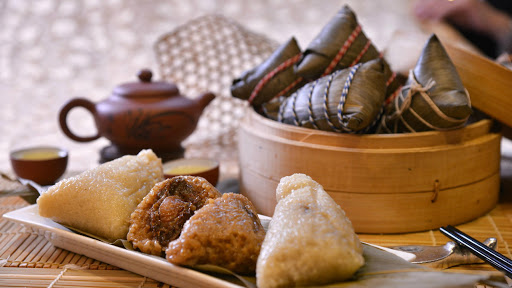
Image credit :Timeourshanghai
Yield: 36 servings
Preparation: 12 hours
Cooking: 4 hours
Ingredients
To assemble the zongzi:
- 75-80 dried bamboo leaves (2 to 3 leaves per zongzi)
- 5 pounds uncooked short grain sticky rice(also called glutinous rice, or “sweet rice”)
- 3 pounds pork belly (and/or pork shoulder)
- Kitchen twine to tie the zongzi
For the pork marinade:
- ¼ cup light soy sauce
- 3 tablespoons dark soy sauce
- 4 teaspoons salt
- 5 tablespoons sugar
- 3 tablespoons Shaoxing wine
- 1 teaspoon ground white paper
- 1 teaspoon five-spice powder
- ¼ cup water (you may not need this, but if you do, you’ll add 2 tablespoons at a time)
For the rice marinade:
- 5 tablespoons light soy sauce
- 5 tablespoons dark soy sauce
- 1½ tablespoons sugar
- 2½ tablespoons salt
Direction
- The night before: Soak the zongzi leaves by weighing them down in a bowl of water with a heavy object. They should be completely submerged. In a large container, soak the glutinous rice in water, making sure the water level is 3-4 inches above the rice, as it will expand considerably as it soaks. Cut the pork belly into 1-inch x 2-inch chunks. Combine the pork with all the marinade ingredients except the water (the light soy sauce, dark soy sauce, salt, sugar, Shaoxing wine, white pepper, and five-spice powder), and mix everything well. It may seem like a lot of salt, but the rice will absorb the saltiness during the cooking process. If there is no visible liquid after mixing, add water, 2 tablespoons at a time. Pork can soak up a lot of liquid and the liquid will help to keep it moist. The pork marinade should be wet, but without too much liquid pooling at the bottom.
- The next day: Completely drain the rice using a fine-meshed colander or sieve. Mix in the rice marinade ingredients (the light soy sauce, dark soy sauce, sugar, and salt), and mix everything well. Set aside, and marinate for about 30 minutes. In the meantime, wash each leaf front and back with a soft cloth, and rinse. Transfer them to a bowl of fresh water until you’re ready to wrap the zongzi so they don’t dry out. Lay out all the components: the pork, the rice, zongzi leaves, and kitchen twine. Now you’re ready to start wrapping zongzi! Follow the step-by-step photos on how to wrap them. There will be visible sauce at the bottom of the rice when you get to the end, simply drain it out once you start to see this, as you don’t want any excess liquid in the zongzi.
- To cook the zongzi, neatly and tightly nest all the zongzi in a large soup pot. Ideally, there will be no visible gaps. If necessary, put a large heatproof plate directly on top of the zongzi to weigh them down. Fill the pot with cold water until they are completely submerged. Place the pot on the stove over high heat. Once the water boils, turn the heat to medium-low, and let it simmer for at least 4-5 hours. The water should be “moving” at a light simmer; definitely not boiling. Check the pot fairly often to make sure the zongzi are always submerged in water. Add only boiling water so the water temperature never gets too low.
For savory sticky rice dumplings, it’s best to eat them when they’re hot or at least warm. No condiments necessary, but sometimes Kaitlin likes to add chili oil to hers. She is weird, but you can be weird too if you want. As a side note, if you are eating sweet zongzi, they are actually best at room temperature or slightly chilled. The glutinous rice becomes even more delightfully chewy when chilled!
2020-05-07T16:00:00Z